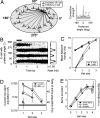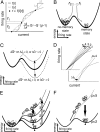Mechanism for top-down control of working memory capacity
- PMID: 19339493
- PMCID: PMC2672558
- DOI: 10.1073/pnas.0901894106
Mechanism for top-down control of working memory capacity
Abstract
Working memory capacity, the maximum number of items that we can transiently store in working memory, is a good predictor of our general cognitive abilities. Neural activity in both dorsolateral prefrontal cortex and posterior parietal cortex has been associated with memory retention during visuospatial working memory tasks. The parietal cortex is thought to store the memories. However, the role of the dorsolateral prefrontal cortex, a top-down control area, during pure information retention is debated, and the mechanisms regulating capacity are unknown. Here, we propose that a major role of the dorsolateral prefrontal cortex in working memory is to boost parietal memory capacity. Furthermore, we formulate the boosting mechanism computationally in a biophysical cortical microcircuit model and derive a simple, explicit mathematical formula relating memory capacity to prefrontal and parietal model parameters. For physiologically realistic parameter values, lateral inhibition in the parietal cortex limits mnemonic capacity to a maximum of 2-7 items. However, at high loads inhibition can be counteracted by excitatory prefrontal input, thus boosting parietal capacity. Predictions from the model were confirmed in an fMRI study. Our results show that although memories are stored in the parietal cortex, interindividual differences in memory capacity are partly determined by the strength of prefrontal top-down control. The model provides a mechanistic framework for understanding top-down control of working memory and specifies two different contributions of prefrontal and parietal cortex to working memory capacity.
Conflict of interest statement
The authors declare no conflict of interest.
Figures




Similar articles
-
Coactivation of prefrontal cortex and inferior parietal cortex in working memory tasks revealed by 2DG functional mapping in the rhesus monkey.J Neurosci. 1994 May;14(5 Pt 1):2775-88. doi: 10.1523/JNEUROSCI.14-05-02775.1994. J Neurosci. 1994. PMID: 8182439 Free PMC article.
-
Maintaining structured information: an investigation into functions of parietal and lateral prefrontal cortices.Neuropsychologia. 2008 Jan 31;46(2):665-78. doi: 10.1016/j.neuropsychologia.2007.09.015. Epub 2007 Oct 6. Neuropsychologia. 2008. PMID: 18022652
-
Mnemonic Encoding and Cortical Organization in Parietal and Prefrontal Cortices.J Neurosci. 2017 Jun 21;37(25):6098-6112. doi: 10.1523/JNEUROSCI.3903-16.2017. Epub 2017 May 24. J Neurosci. 2017. PMID: 28539423 Free PMC article.
-
Cancer 'survivor-care': II. Disruption of prefrontal brain activation top-down control of working memory capacity as possible mechanism for chemo-fog/brain (chemotherapy-associated cognitive impairment).J Clin Pharm Ther. 2013 Aug;38(4):265-8. doi: 10.1111/jcpt.12071. Epub 2013 May 8. J Clin Pharm Ther. 2013. PMID: 23656522 Free PMC article. Review.
-
Specific relationship between prefrontal neuronal N-acetylaspartate and activation of the working memory cortical network in schizophrenia.Am J Psychiatry. 2000 Jan;157(1):26-33. doi: 10.1176/ajp.157.1.26. Am J Psychiatry. 2000. PMID: 10618009 Review.
Cited by
-
A broken filter: prefrontal functional connectivity abnormalities in schizophrenia during working memory interference.Schizophr Res. 2012 Oct;141(1):8-14. doi: 10.1016/j.schres.2012.07.007. Epub 2012 Aug 3. Schizophr Res. 2012. PMID: 22863548 Free PMC article.
-
Selection History Modulates Working Memory Capacity.Front Psychol. 2016 Oct 7;7:1564. doi: 10.3389/fpsyg.2016.01564. eCollection 2016. Front Psychol. 2016. PMID: 27774082 Free PMC article.
-
Development of dopaminergic genetic associations with visuospatial, verbal and social working memory.Dev Sci. 2020 Mar;23(2):e12889. doi: 10.1111/desc.12889. Epub 2019 Aug 6. Dev Sci. 2020. PMID: 31336006 Free PMC article.
-
Cortical hyperactivation at low working memory load: A primary processing abnormality in people with schizophrenia?Neuroimage Clin. 2020;26:102270. doi: 10.1016/j.nicl.2020.102270. Epub 2020 Apr 25. Neuroimage Clin. 2020. PMID: 32388334 Free PMC article.
-
EEG correlates of working memory performance in females.BMC Neurosci. 2017 Feb 13;18(1):26. doi: 10.1186/s12868-017-0344-5. BMC Neurosci. 2017. PMID: 28193169 Free PMC article.
References
-
- Kyllonen PC, Christal RE. Reasoning ability is (little more than) working-memory capacity?! Intelligence. 1990;14:389–433.
-
- Goldman-Rakic PS. Cellular basis of working memory. Neuron. 1995;14:477–485. - PubMed
-
- Gnadt JW, Andersen RA. Memory related motor planning activity in posterior parietal cortex of macaque. Exp Brain Res. 1988;70:216–220. - PubMed
-
- Funahashi S, Bruce CJ, Goldman-Rakic PS. Mnemonic coding of visual space in the monkey's dorsolateral prefrontal cortex. J Neurophysiol. 1989;61:331–349. - PubMed
-
- Curtis C, D'Esposito M. Persistent activity in the prefrontal cortex during working memory. Trends Cognit Sci. 2003;7:415–423. - PubMed
Publication types
MeSH terms
LinkOut - more resources
Full Text Sources
Other Literature Sources
Medical

